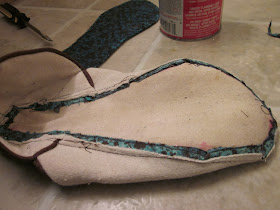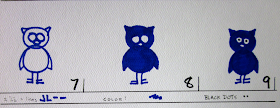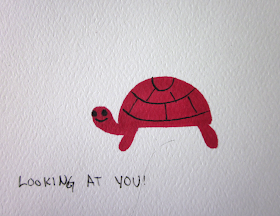 All we have left on the shoes is gluing them together! I decided to try a leather sole for these shoes, but if you would rather use rubber soling material, there is an awesome tutorial on how to do this HERE. Also, if you get confused about my pictures, I am doing the same basic process as the video in the link for the outer sole, just using leather instead. The glue you are going to use is contact cement. (pictured at right)
All we have left on the shoes is gluing them together! I decided to try a leather sole for these shoes, but if you would rather use rubber soling material, there is an awesome tutorial on how to do this HERE. Also, if you get confused about my pictures, I am doing the same basic process as the video in the link for the outer sole, just using leather instead. The glue you are going to use is contact cement. (pictured at right)For the insoles, I flipped the shoes inside out and applied glue to the seam allowance around the outside. Apply liberally. Also apply glue to the area just inside the sole area.
Then you will press them down to the bottom of the shoe, trying to avoid wrinkles so that it lays as flat as possible.Wait for the glue to become sticky, so that if you press your finger on it, strings will form as you take your finger away.
Next you will apply TWO layers of glue to both the sole area of the shoes, and to the bottom of the insoles. The extra layer is to ensure that the glue it not all soaked up into the threads of the fabric. Wait for the glue to become sticky.
Carefully place the insole on top of the sole piece, making sure it lines up well with all sides. If you align it poorly, you can peel it off and apply again, but make sure to work fairly quickly so that the glue does not dry too much. If this happens though, you can apply another layer of glue to both sides, wait for it to get sticky, and try again. Make sure to flip your shoes right side out and smooth out any wrinkles.
You should now wait for the insoles to dry fully before completing the next step. Read the labels on your glue, but mine says it will be bonded instantly, but reaches maximum strength in 7 days. I waited about 24 hours to make sure it was plenty dry. I was too impatient to wait longer, especially since I was just going to be gluing it again. :)
Stay tuned for the leather part of the soles!
Happy cobblering!


















































